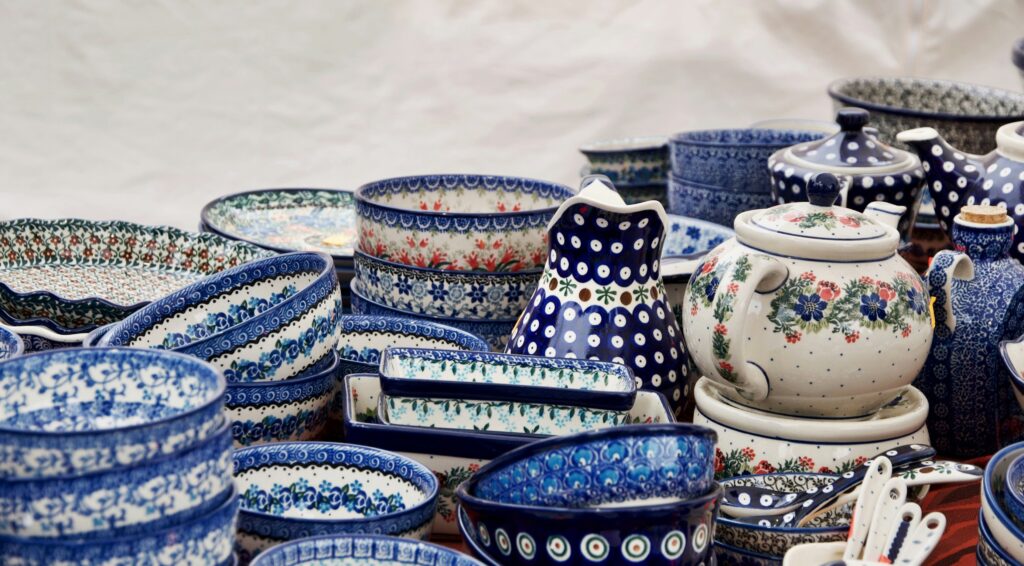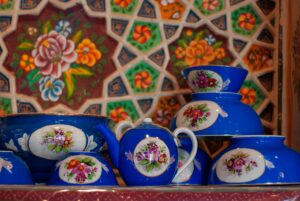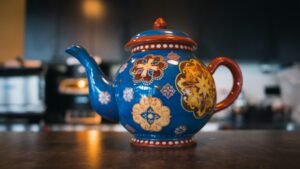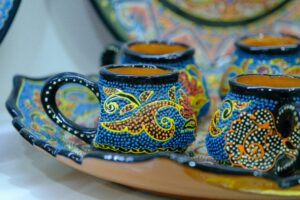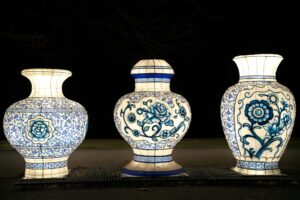Introduction
Multan is located in the center of southern Punjab, an old city that is often called “Saints City”. In addition to its spiritual significance and magnificent architecture, Multan has long been a center of artistic innovation, especially through the craft of Multan Blue Pottery. This specific form of ceramic art, known for its complex designs and signature cobalt glass, represents centuries of cultural exchange, crafts, and flexibility.
Table of Contents
1. Origins Rooted in Persian Influence
The origin of blue tools during the initial Islamic period can be traced back to Central Asia and Persia. Unlike traditional clay-based ceramics, blue tools were developed using quartz, glass, free and white clay mixture, which enabled more delicate and translucent forms. This technique was introduced in South Asia through trade routes and cultural exchange with the Islamic world.
After the Middle Ages, Multan emerged as an important center for this craft because of its strategic location and strong SUFI traditions. The city’s craftsmen began to include local motifs and styles in Persian-inspired designs, which are now recognized as Multan Blue Pottery. Over time, it became an important part of regional identity and Punjab’s cultural heritage.
2. Unique Characteristics of Multan Blue Pottery
The material and method combined to differentiate Multan blue pottery from other pottery. The process is primarily done without wheels and encompasses highly technical molding and casting methods. A fine paste made with powdered quartz, glass frit, and white clay is either poured into plaster molds or worked by hand. Once cast or molded, the piece sun-dries for a while to give the surface some check. After that, it is low-fired once.
After cooling down, the surfaces are polished and painted with cobalt oxide in elaborate flower, geometric, and calligraphic patterns that impart the millennia of blue color to the pottery. Later, it is glazed, after which these pieces are re-fired to fix the design permanently. The two-time firing system supplies durability, at the same time ensuring that all delicate details of blue pottery are maintained.
The patterns in Multan blue pottery have deep symbolism, with great amounts inspired by nature, Islamic geometry, and Arabic script. The designs reflect aesthetic beauty and profundity of spirit, hence, rendering the wares not mere decorative objects but vessels of cultural meaning.
3. Cultural Significance and Religious Influence
Historically, Blue Pottery played an important role in the decoration of religious and historical places in Multan. It was usually used to beautify the graves, temples, and mosques, especially those dedicated to the venerable Sufi-Saint such as Shah Rukan-e-alum and Bahauddin Zakaria. The lively tiles and decorative panels made with this method were added to the visual splendor of these sacred places, and painted pilgrims and visitors the same.
Beyond its religious use, Multan Blue Pottery also found its way into the homes, where it used to beautify walls, ceilings, and countertops. Its presence in domestic surroundings showed the integration of traditional crafts into everyday life, which strengthens the relationship between art and identity.
Today, while use has expanded to modern interior design and fashion, the essence of blue tools is bound to the cultural drug in the Multan and Broad Punjab region.
4. Decline and Challenges in the 20th Century
The surviving legacy of blue pottery has long been a thing of magnificence, but a decline in the 20th century followed suit. The processes of industrialization and mass production ensured that consumers preferred cheaper options that would get to them swiftly instead of handmade craftwork. Reduced demand forced a number of artisans out of the profession, thereby slowly strangling skills taught over the generations.
Formal training programs and institutional backing posed another hurdle. Absence of such a settled system of education meant that any causative interest in the younger generations towards blue pottery as a relevant pursuit stood nil. In addition, the acquisition of equipment of good quality, such as quartz and cobalt oxide, was rendered more and more difficult, which put a big damper on the existence of this craft.
5. Efforts Toward Revival and Preservation
Different efforts have been made in recent decades to revive and maintain the craft, recognizing the value of Multan Blue Pottery as a symbol of cultural heritage. Government bodies such as the Punjab Institute of Language, Art and Culture (Pilac) and non-governmental organizations have initiated initiatives with a view to promoting traditional crafts and supporting craftsmen.
Professional fitness centers have been established to teach young students to teach the techniques of blue tools, and ensure that the skill is not lost over time. Exhibitions, cultural festivals, and artisan markets have also provided platforms for the craftsmen to show their work to wider target groups.
In addition, digital marketing and e-commerce have opened new ways for Multan Blue Pottery to reach global buyers. The electronic marketplace, social media campaigns, and virtual exhibitions have enabled craftsmen to join international collectors and enthusiasts, who have resuscitated interest in this historic craft.
6. Integration into Contemporary Design
One of the most exciting developments in recent years has been the integration of blue tools into modern design. Interior architects, architects, and fashion houses have begun to include elements of multan-blue ceramics in modern interiors, furniture, and accessories.
From mosaic wall panels to custom light fixtures and decorative crockery, blue ceramics are re -reconnected in ways that respect the tradition of appealing to modern taste. Some studios even experiment with color variation and hybrid styles, combining blue pots with other regional crafts to create innovative, liberal functions.
This development suggests that Multan Blue Pottery is not only the remnants of the past, but a vibrant art form that is able to use today’s needs and aesthetics.
7. Supporting the Future of Multan Blue Pottery
In order to ensure the continuous existence of Multan Blue Pottery, continuous support from both the public and private sectors is necessary.
Educational institutions can play an important role in incorporating traditional craftsmanship and encouraging research in the history and techniques of blue ceramics. Collaboration between artists, designers, and historians can lead to innovations and interpretations, while Craftsmen maintain relevant and inspiring future generations.
In addition, it is important to raise awareness of the cultural and historical value of Multan Blue Pottery among the audience to promote praise and pride in this unique art form.
8. Conclusion
Multan Blue Pottery stands as a testament to the artistic simplicity and cultural prosperity of Punjab. Its journey from the Royal Courts of Persia shows centuries of cross-cultural exchange and crafts from the Royal Courts in Multan. Despite having many challenges, it can withstand the art form, thanks to craftsmen, cultural advocates, and support institutions.
As consciousness increases and promotes efforts to preserve this inheritance, it is hopeful that blue ceramics will not only live in modern times, but will grow. Through education, innovation, and praise, Multan can continue to enjoy future generations and contribute to the legacy of Multan Blue Pottery – a real gem of Pakistan’s artistic heritage.
Q1: What is Multan Blue Pottery?
A: Multan Blue Pottery is a traditional ceramic art form from Multan, Pakistan. It uses a unique blend of quartz, glass frit, and white clay, painted with cobalt-blue designs inspired by Persian and Islamic motifs.
Q2: Why is Multan associated with this craft?
A: Multan became a center for blue pottery due to its historical trade links with Persia and Central Asia. Local artisans adapted Persian techniques to create a distinct style now known as Multan Blue Pottery.
Q3: Is Multan Blue Pottery still practiced today?
A: Yes! Despite challenges like industrialization and lack of skilled artisans, efforts are being made to revive and preserve this heritage through training programs, exhibitions, and online marketplaces.

